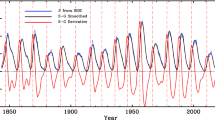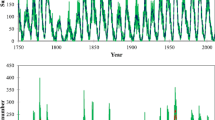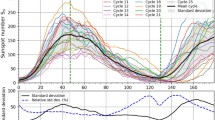Abstract
Examined are associational aspects as they relate the maximum amplitude R M for the sunspot cycle to the rate of rise R Δt during the ascending phase, where R M is the smoothed sunspot number at cycle maximum and R Δt is the sum of the monthly mean sunspot numbers for selected 6-month intervals (Δt) measured from cycle onset. One finds that, prior to about 2 yr into the cycle, the rate of rise is not a reliable predictor for maximum amplitude. Only during the latter half of the ascent do the fits display strong linearity, having a coefficient of correlation r ≃ 0.9 and a standard error S yx ≲ 20. During the first four intervals, the expected R M and the observed R M were found to differ by no more than 20 units of smoothed sunspot number only 25, 42, 50, and 58 % of the time; during the latter four intervals, they differed by no more than 20 units 67, 83, 92, and 100% of the time.
Similar content being viewed by others
References
Brown, G. M. and Simon, P. A.: 1986, in P. A. Simon, G. Heckman, and M. A. Shea (eds.), Solar-Terrestrial Predictions: Proceedings of a Workshop at Meudon, France, June 18–22, 1984, NOAA, Boulder, Colorado, p. 1.
De Jager, C: 1959, in S. Flügge (ed.), Encyclopedia of Physics, Vol. LII, Astrophysics III: The Solar System, Springer-Verlag, Berlin, p. 80.
Eddy, J. A.: 1977, in O. R. White (ed.), The Solar Output and Its Variation, Colorado Associated University Press, Boulder, Colorado, p. 51.
Everitt, B. S.: 1977, The Analysis of Contingency Tables, John Wiley & Sons, Inc., New York.
Howard, R.: 1977, in A. Bruzek and C. J. Durrant (eds.), Illustrated Glossary for Solar and Solar-Terrestrial Physics, Vol. 69, Astrophysics and Space Science Library, D. Reidel Publ. Co., Dordrecht, Holland, p. 7.
Lapin, L. L.: 1978, Statistics for Modern Business Decisions, 2nd ed., Harcourt Brace Jovanovich, Inc., New York.
McKinnon, J. A.: 1987, Sunspot Numbers: 1610–1985, Report UAG-95, World Data Center A for Solar-Terrestrial Physics, Boulder, Colorado.
McNish, A. G. and Lincoln, J. V.: 1949, Trans. AGU 30, 673.
Schatten, K. H. and Sofia, S.: 1987, Geophys. Res. Letters 14, 632.
Waldmeier, M.: 1935, Astron. Mitt. Zurich 14, No. 133.
Waldmeier, M.: 1957, Z. Astrophys. 43, 29.
Waldmeier, M.: 1961, The Sunspot-Activity in the Years 1610–1960, Schulthess and Co., Zurich, Switzerland.
Wilson, R. M.: 1984, A Comparative Look at Sunspot Cycles, NASA Technical Paper 2325, Marshall Space Flight Center, Alabama.
Wilson, R. M.: 1988a, J. Geophys. Res. (in press).
Wilson, R. M.: 1988b, Solar Phys. (in press).
Wilson, R. M.: 1988c, Geophys. Res. Letters 15, 125.
Author information
Authors and Affiliations
Rights and permissions
About this article
Cite this article
Wilson, R.M. Predicting the maximum amplitude for the sunspot cycle from the rate of rise in sunspot number. Sol Phys 117, 179–186 (1988). https://doi.org/10.1007/BF00148581
Received:
Issue Date:
DOI: https://doi.org/10.1007/BF00148581




